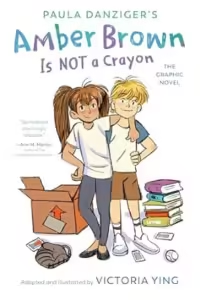Amber Brown is Not a Crayon: The Graphic Novel
Paula Danziger
Adapted and Illustrated by Victoria Ying
G. P. Putnam’s Sons
Published May 21, 2024
Amazon | Bookshop | Goodreads
About Amber Brown is Not a Crayon: The Graphic Novel
Even when her best friend is moving away, Amber Brown is always bold, bright, and colorful. #Amber Brown is out now on Apple TV+
Amber Brown and Justin Daniels are best friends. They’ve known each other for practically forever, sit next to each other in class, help each other with homework, and always stick up for each other. Justin never says things like, “Amber Brown is not a crayon.” Amber never says, “You’re Justin Time.” They’re a great team—until disaster strikes. Justin has to move away, and now the best friends are fighting. Will they be able to work it out before it’s too late?
Along with the ups and downs of shared custody, the Amber Brown chapter books are beloved for tackling relatable dilemmas with thoughtfulness, humor, and plenty of puns.
My Review
I don’t usually review chapter books, but sometimes the overlap with a middle grade audience is pretty high. This one is a graphic novel adaptation of a popular chapter book series by Paula Danziger that came out decades ago. I haven’t read the original, so I can’t compare it to this adaptation.
I loved the expressive faces on the characters in this graphic novel. The characters experience a broad range of emotions and their faces clue readers into what they’re feeling, very often with a comedic flare.
The opening pages introduce us to Amber as her class prepares for an imaginary flight to China. Her teacher serves as the pilot, and the class learns different things about Chinese history and culture as part of the “trip.” I thought that was a cool idea. We also get to know Amber’s best friend, Justin, whose family is about to move from New Jersey to Alabama. As the story progresses, Amber and Justin deal with the move in ways that drive a wedge between them. With the move date drawing near, Amber is at a loss for how to save her friendship with Justin and enjoy the last of her time with him.
What a cute book! I already mentioned the facial expressions, but they’re my favorite part of the book. They communicate feelings and, many times, add humor and charm to the story. I like Amber’s spunky attitude and that she and Justin have different strengths and interests yet are still best friends.
This is a fun read for kids as they age up from chapter books to middle grade novels. It’s got a lot of humor but explores a complex emotional moment in a friendship that’s relatable to a lot of kids.
Content Notes
Recommended for Ages 7 to 10.
Representation
Most characters are white/white-passing. Amber’s teacher and a classmate are BIPOC.
Profanity/Crude Language Content
None.
Romance/Sexual Content
References to Amber’s parents’ divorce.
Spiritual Content
None.
Violent Content
A girl calls Amber “messy,” and she tries to charge at the girl angrily. Justin holds her back.
Drug Content
None.
Note: This post contains affiliate links, which do not cost you anything to use but help support this blog. I received a free copy of this book in exchange for my honest review. All opinions are my own.
